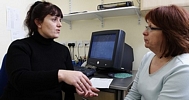Kettlebell Training and Barefoot Training
Ok so imagine living with your hands strapped up in cotton wool and living your whole life without being able to use your hands. Can you just imagine how irritating this would be as you would not be able to pick things up properly. In fact this is like wearing air system shoes all day long, where you are not able to spread your toes and feel the ground that we walk on. All the nerve endings, motor sensors, joints and bones in our feet are protected and very rarely see daylight at all.
But if you go far back to cave men and women times where we first evolved over thousands of years ago we survived perfectly well without having our feet strapped up in colourful air system shoes on our feet. There are many modern day examples of how barefoot training can help aid physical performance particularly in Kettlebell Training. Even Zola Budd the marathon runner favoured barefoot training when she ran marathons, and there is research to show that running barefoot ensures correct body mechanics.
In his book "Take Off Your Shoes and Walk" foot Doctor Simon J. Wikler D.S.C., states that,
"Practically all shoes worn daily by men and women in our Western civilization have little relation to the shape of the human foot - Most adults' foot trouble would either not exist or would be much less bothersome if properly-shaped shoes had been worn during childhood or, better yet, if those people had gone barefoot"
So what are the benefits of barefoot training anyway?
Enhanced running efficiency;
Laboratory research has shown that running barefoot results in a 4% increase in performance. It is seen that the arches of the foot are allowed to move more freely without the need for air system shoes!
·More ability to spread your toes-yes you will have the freedom to spread and get some air on your toes!
·Stronger muscles in your feet and legs-When running barefoot on hard surfaces, the runner compensates for the lack of cushioning underfoot by plantar-flexing the foot at contact, thus giving a softer landing (Frederick, 1986). Barefoot runners also land mid-foot, increasing the work of the foot's soft tissue support structures, thereby increasing their strength and possibly reducing the risk of injury (Yessis 2000, p.124).When running barefoot on hard surfaces, the runner compensates for the lack of cushioning underfoot by plantar-flexing the foot at contact, thus giving a softer landing (Frederick, 1986).
·Greater agility and balance- It is claimed that footwear increases the risk of such sprains, either by decreasing awareness of foot position provided by feedback from plantar cutaneous mechanoreceptors in direct contact with the ground (Robbins et al., 1995), or by increasing the leverage arm and consequently the twisting torque around the sub-talar joint during a stumble (Stacoff et al., 1996). Siff and Verkhoshansky (1999, p.452) reported that running shoes always reduce proprioceptive and tactile sensitivity, and that using bare feet on the high-density chip-foam mats in gyms preserves proprioceptive sensitivity. Robbins et al. (1989) considered that behaviors induced by plantar tactile sensations offer improved balance during movement, which may explain the preference of many gymnasts and dancers for performing barefoot.
·Greater flexibility in your leg muscles- goes without saying really. If your feet aren't strapped up all day in comfy shoes then they are going to be able to move freely whoch will help your feet and legs get better range of motion-thus increasing flexibility.
·Improved posturewhich may help reduce lower back pain-walking barefoot means, inherently, that the only heel you're walking on is your own. Walking wearing standard shoes means, almost inevitably, you'll have an extra heel. Any change in the orientation of the heel instantly changes the mechanics of the arch of the foot, but importantly also changes the mechanics of the low back - increasing the curve. An increased curve in the low back means that the small facet joints on the back of the spine which are not designed for weight bearing (Bogduk 2003) become loaded and, across time, painful.
·Improved circulationbecause the motion you get from your unrestricted foot when walking barefoot activates a number of muscles in people's feet and legs, which in turn helps to pump blood back to their hearts. This motion may not be as effective if your foot is confined in a shoe, especially if it's a poor fitting shoe. This muscle action prevents the pooling of blood in your feet and legs, reducing the stress on the entire cardiovascular system and reducing blood pressure. This is why going barefoot is recommended to prevent deep vain thrombosis.
·A better contact to naturebecause life-force energy called Chi (also called Qi or Prana) can only be absorbed through the soles of the feet. Ground Chi is absorbed automatically and unconsciously when walking barefoot, which may be one of the reasons why it's so relaxing to walk without shoes on and why exercises geared toward strengthening the body and relaxing the mind (yoga, tai chi, martial arts) are also typically practiced barefoot.
-Facilitated venous return
Decreased blood pressure; this is true - particularly if walking on uneven ground (ie cobbled streets or off road). The walking itself, of course, helps to support good cardiovascular function but, in addition, the fact that the foot strikes the ground at a slightly different angle with each step and is allowed to roll over the naturally convex heel (rather than a flat, straight, rubber plate) means that multiple muscle groups are activated resulting in greater pumping of blood back through the valve-based venous system (Vines 2005). People in Germany, Austria and Switzerland can visit "barefoot parks" and walk along "paths of the senses" - with mud, logs, stone and moss underfoot - to receive what's known there as reflexzonmassage. Reflexologists have long advocated walking on textured surfaces to stimulate so-called "acupoints" on the soles of the feet. Practitioners of this complementary therapy believe that pressure applied to particular spots on the foot connects directly to corresponding organs and can enhance their function.
Reduced risk of deep vein thrombosis; for the same reason as above there is less pooling of blood in the lower leg and enhanced venous return.
Lower incidence of varicose veins; because there is improved venous return, blood does not rest in the veins increasing pressure on the vein walls and creating varicosities. Instead it is pumped back to the heart through enhanced muscular use in the lower leg.
-Decreased ankle sprains
it is claimed that increased awareness of foot position from direct contact with the ground (Robbins et al., 1995) may decrease risk of ankle sprain - and/or the reduced leverage and consequently twisting around the ankle (sub-talar) joint from going "barefoot" minimizes the risk of spraining the joint during a stumble (Stacoff et al., 1996).
-Better proprioceptionThe modern running shoe and footwear generally reduce sensory feedback, apparently without diminishing injury-inducing impact-a process Robbins and Gouw (1991) described as the "perceptual illusion" of athletic footwear. A resulting false sense of security may contribute to the risk of injury (Robbins and Gouw, 1991). Yessis (2000, p.122) reasoned that once the natural foot structures are weakened by long-term footwear use, people have to rely on the external support of the footwear, but the support does not match that provided by a well functioning foot.
-Increases biomechanical performance- the arches of the feet are shock absorbers for the foot. They store energy and return energy to the gait cycle. Similarly, the natural arches of the spine are designed to perfectly store energy as the body "derotates" during the gait cycle (Gracovetsky 1988, 1997, 2001). Wearing shoes that have arch supports prevent the arches from functioning properly and heels cause chaos to posture as they compromise energy storage and change the sdhape of the spine which cause back problems and neck problems.
-Reduced risk of bunionsthe big toe is often pushed towards the middle of the foot and the same is true of the little toe when wearing traditional shoes. Heels on a shoe load the big toe and cause more strain and the hallux longus is strained and here bunions develop.
-Improves balance and prevents falls;
The feet provide significant sensory feedback to the brain and are therefore significant in balance and efficiency when running or walking. But , (Chek 2004) sees the most common cause of death in people above 65 years is falling. 25% of elderly people who fall and fracture a hip, die within 1 year of falling.
So how can going barefoot help me with my Kettlebell Training?
When you go barefoot when kettlebell training your movements not only become the movements of a child-playful and sensitive, yet purposeful and confident, but you experience the unbound joy of being able to grip and feel the floor better and being able to balance better whilst performing ballistic movements like 2 arm swings. This is called 'rooting' in kettlebell training where your feet are in contact with the ground.
A strong base of support is also required for strength exercises like squats. Rooting will help you become more stable and movements like swings, squats or presses will naturally align you into a more powerful position that will significantly increase and lengthen your ability to produce force. The improved alignment of your body also ensures that you are safer training.
Rooting and Kettlebell Training
Jamie Lloyd of Russian Kettlebells UK tecahes rooting to his clients so that they form a more powerful foot to ground connection. The first step is becoming aware of your technique and to feel the ground underneath you when performing exercises like kettlebell swings and the kettlebell squats.
Body awareness is essential for learning proper form when kettlebell training. First, become aware of how you lift a kettlebell from the floor. This will work best if you do them in barefoot. Now lift your kettlebell or weight off the floor and do 5 repetitions.
Take a few seconds and think about how you felt. Where did you feel the weight shift into your feet? Was it in the heels or in your toes? Did your feet come off the floor? Being aware of these feelings is important in properly aligning your body when you are picking up a kettlebell.
Rrooting is becoming aware and influencing how your body is aligned through the contact of your feet and the ground. This is done by focusing on how your feet are connected to the floor by three contact points. The first contact point is located on the heels (point one). Next are the points just under the big toes (point two). The last one is under the little toes (point three). Look at the diagram to view these contact points below.

By constantly contacting these points the body will align itself naturally.
The following steps will help increase your awareness of the three contact points of rooting:
- Shift your weight back onto your heels so your toes lift off the ground. Feel for where your heels make contact with the floor (point 1).
- Go onto your toes. Feel for the two contact points on the balls of your feet. These are the inner (2) and outer (3) points of the upper foot.
- Then bring your knees together so you feel your weight shift to your insides of your feet. Feel for the point (2) just below your big toes that are in contact with the floor.
- Then move your knees apart and feel your weight shift to your outer foot. Feel for the point (3) just below your little toes that are in contact with the floor.
Once you have learned the three contact points, then to learn how to root them.
This is what you do:-
Stand up tall, move one knee inwards. You should feel your outer foot come away from the ground and point three lose contact. Thn push back into point three. Don't shift your bodyweight to reconnect. By pushing back into point three, you will find that your knee realigns naturally.
You can do this with all the above exercises in the same manner. Closing your eyes will increase your proprioception and awareness.
Lastly,go back to your kettlebell. Find a strong root and spread your toes and then lift the kettlebell off the ground. Focus on maintaining constant contact through the three points; think of anchoring your feet to the floor .
Putting rooting into practice into your kettlebell training
Let's look how you can use rooting and barefoot training in your kettlebell exercises.
The body needs to work as a whole unit. If the body is unstable then it has to work on keeping itself stable. If you fall over you must activate and fire up your muscles up to stop you falling. Through proper rooting, alignment and stability you will have a more solid foundation for lifting kettlebells. Instead of muscles being used to balance the body they can now be used to help you push more weight .
Squatting
The first exercise would be squats. A lot of people have poor alignment when squatting. So rememeber the contact points for rooting and stay connected through the ground and keep the weight on your heels with your knees tracking in line with your toes. If you feel that you are losing connection with any of the points, look at your toes, reconnect and your body will naturally realign. Try to maintain a strong base and push through the heels.
Military Press
When the weight gets too heavy to lift some people tend to lean to one side get the kettlebell up. This is because your body is not properly rooted into the ground . If you have established a good base and are properly rooted and your abdomials are braced you will have better alignment and you will be able to press more efficiently.
Swings
Establish a solid base, keep your weight onto your heels- don't come onto your toes or the bell will run away from you. Keep connected to the floor as if your feet are screwed down and drive. You will then feel that your swings are more powerful and efficient.
So when kettlebell training train in bare feet and be aware of working from the ground up before you lift. Ensure that you take the correct steps to maintain proper alignment and through practice it will become easier and you will feel like all your kettlebell exercises are more fluid, safer and stronger.
For more on kettlebell training, kettlebell courses, kettlebell classes and kettlebells contact Jamie Lloyd BSc RKC CKT
He is based in Wimbledon, London and regularly coaches kettlebell training to personal traners and fitness enthusiasts.
Check out:-



